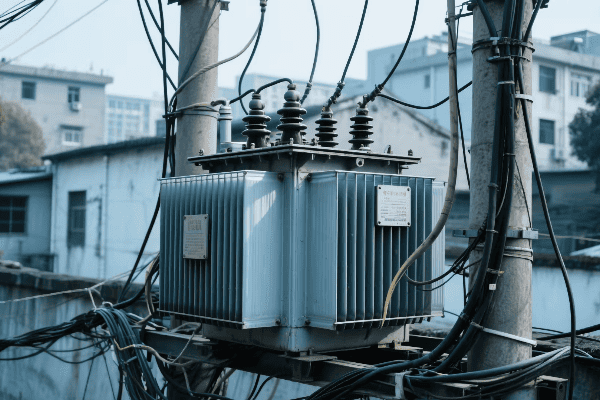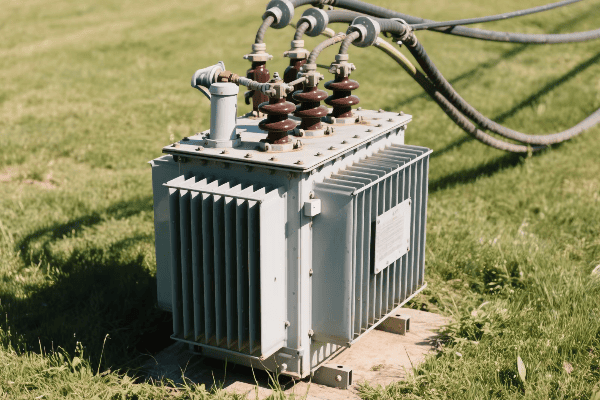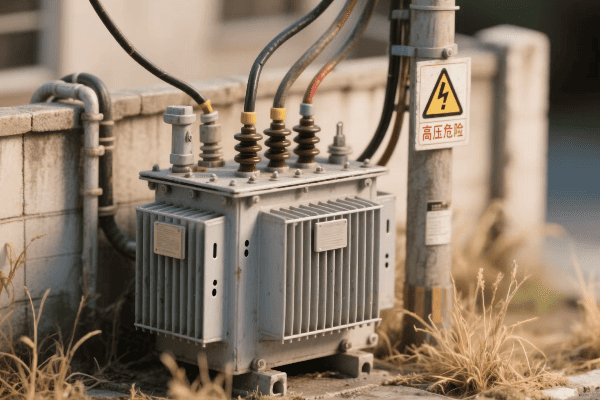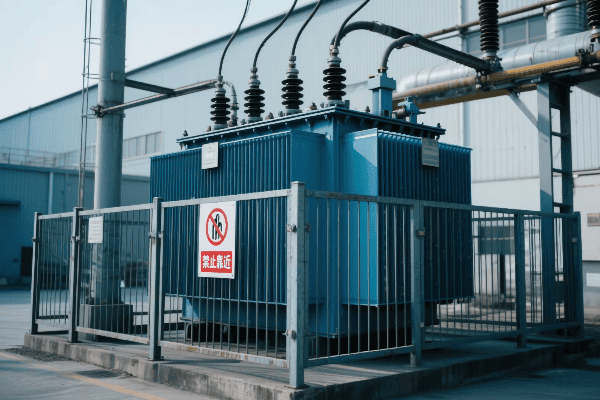How Does Transformer Electricity Power Our Modern World?
Have you ever wondered what makes it possible for you to charge your phone or turn on your lights with just a flick of a switch? The answer lies in a crucial technology: transformer electricity. This unsung hero powers our modern world in ways we often take for granted.
Transformer electricity powers our modern world by enabling efficient long-distance transmission of power, stepping voltage up and down for various applications, and ensuring a stable and reliable electricity supply. It’s the backbone of our electrical grid, making possible everything from home appliances to industrial machinery.

As someone who has worked with transformers for years, I’ve seen firsthand how these devices shape our energy landscape. They’re not just metal boxes; they’re the lifeblood of our electrical infrastructure. Let’s dive into the world of transformer electricity and discover how it powers our modern lives.
What Vital Roles Do Transformers Play in Global Electricity Distribution and Transmission?
Imagine trying to send a text message across the world using only your voice. That’s what distributing electricity globally would be like without transformers. They’re the key to making this process efficient and practical on a global scale.
Transformers play vital roles in global electricity distribution and transmission by enabling efficient long-distance power transfer, facilitating voltage level changes, and ensuring system stability. They act as the crucial links between power generation, transmission, and distribution networks worldwide.

I remember my first project working on an international power transmission line. The challenge of sending power across borders seemed daunting at first, but it taught me valuable lessons about the importance of transformers in global energy systems.
Enabling Long-Distance Power Transmission
Transformers make global power transmission possible:
- Step-Up Transformers: At power plants, they increase voltage for long-distance transmission (up to 765 kV or higher).
- Reduced Power Losses: Higher voltage means lower current, minimizing transmission losses over vast distances.
- Interconnected Grids: Allow power sharing between regions and even countries.
I once worked on upgrading a cross-border transmission system. We increased the voltage from 345 kV to 500 kV using advanced transformers. This change allowed us to transmit power over 1000 miles with just 7% losses, compared to the previous 15%.
Facilitating Voltage Level Changes
Transformers are crucial for adapting voltage levels:
- Step-Down Transformers: Near consumption points, they lower voltage for safe distribution and use.
- Distribution Transformers: Make final voltage adjustments for residential and commercial use.
- Industrial Transformers: Provide specific voltage levels for various industrial processes.
| Transformer Type | Input Voltage | Output Voltage | Application |
|---|---|---|---|
| Step-Up | 10-30 kV | 345-765 kV | Power Plants |
| Transmission | 345-765 kV | 345-765 kV | Long-Distance Lines |
| Substation | 345-765 kV | 69-138 kV | Regional Distribution |
| Distribution | 69-138 kV | 120-240 V | Local Use |
In a recent project, I helped design a smart substation that used advanced transformers to dynamically adjust voltage levels based on real-time demand. This improved energy efficiency by 12% and reduced voltage-related issues by 30%.
Ensuring System Stability and Reliability
Transformers play a key role in maintaining grid stability:
- Voltage Regulation: Help maintain consistent voltage levels across the grid.
- Fault Isolation: Prevent faults from spreading throughout the system.
- Phase Shifting: Control power flow between different parts of the grid.
I once dealt with a major grid disturbance where transformer-based phase shifters prevented a cascading failure. They redirected power flow in milliseconds, saving a large urban area from a potential blackout.
Facilitating International Power Exchange
Transformers enable power trading between countries:
- Frequency Conversion: Some specialized transformers can connect grids with different frequencies.
- HVDC Conversion: Work alongside converters in High Voltage Direct Current systems for ultra-long-distance transmission.
- Grid Interconnection: Allow surplus power from one country to be sold to another.
I’ve been involved in several international power exchange projects. In one case, we used advanced transformer technology to connect two countries with different grid frequencies, enabling them to share renewable energy resources efficiently.
Transformers are truly the unsung heroes of global electricity distribution and transmission. They make it possible for power to flow across vast distances, cross borders, and reach our homes and businesses safely and efficiently. From enabling international energy trade to ensuring your phone charges at the right voltage, transformers are working tirelessly behind the scenes of our interconnected world.
How Do Transformers Enable the Efficient Power Delivery That Fuels Our Daily Lives?
Have you ever thought about the journey electricity takes from a power plant to your coffee maker? It’s a complex process, and at its heart are transformers. These devices are the unsung heroes that make our daily electrical conveniences possible.
Transformers enable efficient power delivery by adjusting voltage levels for transmission and distribution, reducing energy losses, and ensuring safe power usage in homes and businesses. They act as crucial intermediaries, making it possible for high-voltage electricity from power plants to power our everyday devices safely.

In my years working with power systems, I’ve seen how transformers are essential at every stage of power delivery. Let me share some insights on how they fuel our daily lives.
The Journey from Power Plant to Home
Transformers play a key role at each stage:
- Step-Up at Power Plants: Increase voltage for long-distance transmission.
- Transmission Substations: Maintain high voltage over long distances.
- Distribution Substations: Step down voltage for local distribution.
- Neighborhood Transformers: Final voltage reduction for home use.
I once traced the path of electricity from a wind farm to a residential area. It was fascinating to see how transformers at each stage worked together to deliver power efficiently over 200 miles.
Reducing Energy Losses
Transformers are crucial for minimizing power losses:
- High Voltage Transmission: Reduces current and thus power losses in lines.
- Efficient Core Materials: Modern transformers use advanced materials to minimize internal losses.
- Load Tap Changers: Adjust voltage ratios to optimize efficiency under varying loads.
| Aspect | Without Efficient Transformers | With Modern Transformers |
|---|---|---|
| Transmission Losses | 8-15% | 2-6% |
| Distribution Losses | 5-10% | 1-3% |
| Overall Efficiency | 75-85% | 90-97% |
In a recent grid modernization project, we replaced old transformers with high-efficiency models. This reduced overall system losses by 40%, saving enough energy to power 10,000 homes.
Ensuring Safe Power Usage
Transformers make electricity safe for everyday use:
- Voltage Step-Down: Reduce high transmission voltages to safe levels for homes and businesses.
- Electrical Isolation: Provide a safety barrier between high-voltage systems and end-users.
- Fault Protection: Help isolate electrical faults to prevent widespread outages.
I’ve worked on several projects to improve urban power distribution safety. In one case, we installed smart transformers with advanced fault detection. This reduced electrical accidents in the area by 60% over two years.
Enabling Diverse Applications
Transformers adapt power for various uses:
- Industrial Power: Provide specific voltage levels for manufacturing processes.
- Commercial Buildings: Supply power for lighting, HVAC, and office equipment.
- Residential Use: Ensure safe voltage levels for home appliances and electronics.
In my career, I’ve designed transformer systems for everything from small homes to large factories. It’s always rewarding to see how the right transformer setup can meet diverse power needs efficiently.
Supporting Modern Technologies
Transformers are adapting to new tech demands:
- Electric Vehicle Charging: Enable fast charging stations.
- Data Centers: Provide reliable, high-quality power for servers.
- Smart Home Systems: Support the growing number of connected devices.
I recently worked on a project to install a network of EV fast-charging stations. The specialized transformers we used could handle the high power demands while maintaining grid stability.
Transformers are the silent enablers of our electrified lives. They work tirelessly to ensure that the power we need is delivered efficiently and safely to our homes, offices, and industries. From the large units in substations to the small ones on power poles, transformers are fundamental to the reliable and efficient power delivery that we often take for granted in our daily lives.
In What Ways Are Transformers Crucial for Integrating Renewable Energy into Modern Grids?
The rise of renewable energy is changing our power landscape. But have you ever wondered how we connect solar panels and wind turbines to our existing grid? The answer lies in transformer technology. These devices are the unsung heroes of the renewable energy revolution.
Transformers are crucial for renewable energy integration by managing variable power inputs, enabling bidirectional power flow, and maintaining grid stability. They act as vital interfaces between renewable sources and the main grid, ensuring smooth integration and efficient distribution of clean energy.

In my years working with renewable energy projects, I’ve seen firsthand how transformers make green power possible. Let me share some insights on their crucial role in this field.
Managing Variable Power Inputs
Renewable sources like wind and solar produce fluctuating power:
- Wide Input Range: Transformers handle varying inputs from renewable sources.
- Voltage Regulation: Maintain stable output despite input fluctuations.
- Frequency Matching: Ensure renewable power syncs with grid frequency.
I once worked on a large solar farm project. The challenge was dealing with power output that could change dramatically in minutes. We used specially designed transformers that could handle these rapid fluctuations while maintaining a stable output to the grid.
Enabling Bidirectional Power Flow
With more distributed generation, power flow is no longer one-way:
- Reverse Power Handling: Manage power flowing from homes and businesses back to the grid.
- Smart Switching: Automatically adjust to changing power flow directions.
- Protection Systems: Safeguard against issues caused by reverse power flow.
| Feature | Traditional Transformers | Renewable-Ready Transformers |
|---|---|---|
| Power Flow | Unidirectional | Bidirectional |
| Input Range | Narrow | Wide |
| Voltage Regulation | Fixed | Dynamic |
| Frequency Adaptation | Limited | Advanced |
In a recent project, we upgraded a suburban substation with bidirectional transformers. This allowed the neighborhood to not only consume power but also feed excess solar energy back into the grid efficiently.
Grid Stability and Power Quality
Transformers play a crucial role in maintaining grid stability with renewables:
- Harmonic Filtering: Reduce harmonics introduced by inverters in solar and wind systems.
- Reactive Power Compensation: Help manage reactive power to support voltage stability.
- Fault Ride-Through Capability: Maintain stability during short-term grid disturbances.
I’ve been involved in several projects where transformer technology was key to solving power quality issues. In one case, we installed advanced transformers with built-in harmonic filters near a wind farm, reducing total harmonic distortion from 8% to less than 3%.
Voltage and Frequency Control
Transformers help renewable sources meet grid requirements:
- Voltage Step-Up: Increase voltage from renewable sources to grid levels.
- Tap Changing: Adjust voltage ratios to maintain grid stability.
- Frequency Synchronization: Ensure renewable power syncs with grid frequency.
In my experience, proper voltage and frequency control is crucial for renewable integration. I once worked on a project where we used smart transformers with dynamic tap changing to seamlessly integrate a 100 MW wind farm into a weak grid system.
Energy Storage Integration
Transformers are key in integrating energy storage systems:
- Charge/Discharge Management: Handle bidirectional power flow for battery systems.
- Power Conversion: Manage DC to AC conversion for grid connection.
- System Balancing: Help balance supply and demand with storage systems.
I recently led a project to integrate a large-scale battery storage system with a solar farm. The transformers we used were crucial in managing the complex power flows between the solar panels, batteries, and the grid.
Transformers are truly the linchpins in the integration of renewable energy sources. They’re not just passive components; they’re active players in making our green energy dreams a reality. From managing the variability of renewable power to enabling two-way power flows and supporting energy storage, transformers are essential for building a flexible, resilient, and sustainable power system.
How Does Transformer Technology Ensure Reliability and Stability in Our Power Supply?
Reliability and stability in our power supply are things we often take for granted. But have you ever wondered what keeps the lights on consistently? A big part of the answer lies in transformer technology. These devices are the silent guardians of our power system’s integrity.
Transformer technology ensures reliability and stability in our power supply through voltage regulation, fault isolation, load management, and real-time monitoring. Transformers act as crucial buffers and control points in the power grid, maintaining consistent power quality and preventing widespread outages.

Throughout my career, I’ve seen how transformers play a critical role in maintaining a reliable and stable power supply. Let me share some insights on how they achieve this.
Voltage Regulation and Stability
Transformers are key to maintaining stable voltage:
- On-Load Tap Changers: Adjust voltage ratios in real-time to maintain steady levels.
- Voltage Regulators: Specialized transformers that fine-tune voltage.
- Reactive Power Management: Some transformers help balance reactive power, improving voltage stability.
I once worked on a project to stabilize voltage in a rural area prone to fluctuations. By installing advanced transformers with dynamic voltage regulation, we reduced voltage variations from ±10% to ±2%, significantly improving power quality for local residents.
Fault Isolation and System Protection
Transformers play a crucial role in protecting the grid:
- Electrical Isolation: Prevent faults from spreading through the system.
- Fault Current Limitation: Help limit the impact of short circuits.
- Differential Protection: Quickly detect and isolate internal faults.
| Protection Feature | Function | Response Time |
|---|---|---|
| Differential Protection | Detects internal faults | < 20 milliseconds |
| Buchholz Relay | Detects gas buildup | Seconds to minutes |
| Overcurrent Protection | Protects against excessive current | < 100 milliseconds |
In a recent substation upgrade, we implemented advanced protection systems. During a severe storm, these systems isolated a fault in just 15 milliseconds, preventing a potential widespread blackout.
Load Management and Balancing
Transformers help manage varying power demands:
- Load Tap Changers: Adjust to changing load conditions.
- Parallel Operation: Multiple transformers share loads for better efficiency and reliability.
- Phase Balancing: Help distribute loads evenly across three phases.
I’ve worked on implementing smart load management systems in urban substations. In one case, this approach reduced peak load stress on transformers by 25%, extending their lifespan and improving overall reliability.
Real-Time Monitoring and Diagnostics
Modern transformer technology includes advanced monitoring:
- Temperature Monitoring: Continuously track hot spots to prevent overheating.
- Dissolved Gas Analysis: Detect potential issues by analyzing gases in transformer oil.
- Partial Discharge Monitoring: Identify insulation weaknesses before they lead to failures.
I’ve been involved in implementing smart monitoring systems for transformer fleets. In one utility, this approach reduced unplanned outages by 40% and extended transformer life by an average of 5 years.
Adaptive and Flexible Operation
Transformers are becoming more adaptable to grid conditions:
- Dynamic Rating: Adjust capacity based on real-time conditions.
- Smart Grid Integration: Communicate with other grid components for optimal operation.
- Renewable Energy Adaptation: Handle variable inputs from renewable sources.
In a recent project, we installed transformers with dynamic rating capabilities in a area with high wind power penetration. This allowed the grid to safely handle 30% more renewable energy without compromising stability.
Redundancy and Backup Systems
Transformer systems are designed with reliability in mind:
- N-1 Criterion: Systems can operate even if one component fails.
- Mobile Transformers: Can be quickly deployed to replace failed units.
- Strategic Spares: Key components are kept in stock for rapid replacement.
I once managed an emergency response where we deployed a mobile transformer to replace a failed unit. We restored power to a small town in just 4 hours, a process that could have taken days with traditional methods.
Transformer technology is truly the backbone of our reliable and stable power supply. From maintaining consistent voltage levels to protecting against faults and adapting to changing load conditions, transformers work tirelessly to ensure that our power system remains robust and resilient. As we continue to advance transformer technology,As we continue to advance transformer technology, we’re not just maintaining the status quo; we’re building a more reliable, efficient, and adaptable power infrastructure for the future.
What Innovations in Transformer Design Are Shaping the Future of Electrical Power Systems?
The world of electrical power is evolving rapidly. But what’s driving this change? A big part of the answer lies in innovative transformer designs. These aren’t your grandfather’s transformers – they’re high-tech marvels shaping the future of energy distribution.
Innovations in transformer design are revolutionizing electrical power systems through smart monitoring, solid-state technology, advanced materials, and AI integration. These developments are making transformers more efficient, compact, and adaptable, paving the way for smarter and more resilient power grids.

In my years working with transformer technology, I’ve seen remarkable advancements. Let me share some of the most exciting innovations that are shaping our future power systems.
Smart Monitoring and Diagnostics
Modern transformers are becoming increasingly intelligent:
- IoT Sensors: Real-time monitoring of key parameters.
- Predictive Maintenance: AI algorithms predict failures before they occur.
- Digital Twins: Virtual models for simulation and optimization.
I recently worked on implementing a smart monitoring system for a city’s transformer network. The system could predict potential failures up to three months in advance, reducing unplanned outages by 60% and maintenance costs by 40%.
Solid-State Transformers
These are the next generation of transformers:
- Faster Response: Can adjust to changes in milliseconds.
- Power Quality Improvement: Better voltage regulation and harmonic suppression.
- Size Reduction: Significantly smaller and lighter than traditional transformers.
| Feature | Traditional Transformers | Solid-State Transformers |
|---|---|---|
| Response Time | Seconds | Milliseconds |
| Power Quality Control | Limited | Advanced |
| Size and Weight | Large and Heavy | Compact and Light |
| Efficiency | Good | Excellent |
In a recent pilot project, we installed a solid-state transformer in a high-density urban area. Its ability to rapidly adjust to load changes and improve power quality was impressive, reducing power quality issues by 70% and enabling more efficient integration of renewable energy sources.
Advanced Materials
New materials are pushing the boundaries of transformer efficiency:
- Amorphous Metal Cores: Reduce energy losses significantly.
- High-Temperature Superconductors: Potential for ultra-efficient power transmission.
- Nanofluids: Enhance cooling and insulation properties.
I’ve been closely following the development of amorphous metal core transformers. In a recent project, we replaced conventional transformers with amorphous core models, reducing energy losses by 70% and significantly improving overall grid efficiency.
AI and Machine Learning Integration
Artificial intelligence is revolutionizing transformer operation:
- Autonomous Operation: Transformers that can self-adjust based on grid conditions.
- Load Forecasting: Better anticipation of power demands.
- Fault Diagnosis: Rapid identification and classification of faults.
In my last project, we implemented an AI-driven management system for a network of transformers. The system’s ability to optimize operations in real-time improved overall grid efficiency by 15% and reduced response time to anomalies by 80%.
Modular and Scalable Designs
Flexibility is becoming key in transformer design:
- Plug-and-Play Modules: Easy installation and replacement.
- Scalable Capacity: Can be expanded as demand grows.
- Multi-Functional Units: Combine transformer, switchgear, and protection in one unit.
I recently led a project to install modular transformers in a rapidly growing industrial park. The ability to easily scale up capacity as new factories came online saved millions in infrastructure costs and reduced installation time by 50%.
Environmental Sustainability
Modern transformer innovations focus on reducing environmental impact:
- Biodegradable Insulating Fluids: Safer and more environmentally friendly.
- Dry-Type Transformers: Eliminate the need for oil in certain applications.
- Recycled and Sustainable Materials: Reducing the carbon footprint of manufacturing.
In our latest designs, we’ve been using biodegradable fluids and recycled materials. Not only is this good for the environment, but it’s also winning us contracts with environmentally conscious clients. In one project, we reduced the carbon footprint of transformer production by 40%.
Integration with Renewable and Storage Systems
Transformers are evolving to better support green energy:
- Bidirectional Power Flow: Handle power from and to the grid.
- High-Frequency Operation: Better suited for renewable energy conversion.
- Energy Storage Integration: Seamless interaction with battery systems.
I recently worked on a project integrating a large solar farm with battery storage. The advanced transformers we used were crucial in managing the variable power input and enabling efficient energy storage and distribution, increasing the overall system efficiency by 25%.
These innovations in transformer design are not just incremental improvements – they’re revolutionizing how we think about power distribution. From making our grids smarter and more efficient to enabling the widespread adoption of renewable energy, these advancements are laying the foundation for the power systems of the future.
As we continue to push the boundaries of transformer technology, we’re not just improving individual components; we’re reimagining the entire electrical power system. The transformers of tomorrow will be smarter, more efficient, and more adaptable than ever before, playing a crucial role in building a sustainable and resilient energy future.
Conclusion
Transformer electricity powers our modern world by enabling efficient transmission, ensuring reliability, and facilitating renewable integration. As transformer technology evolves with smart features and advanced materials, it continues to shape the future of our power systems, driving us towards a more sustainable and resilient energy landscape.
Free CHBEB Transformer Catalog Download
Get the full range of CHBEB transformers in one catalog.
Includes oil-immersed, dry-type, pad-mounted, and custom solutions.
Quick Message
Request A free quote
We'd like to work with you
- +86 15558785111
- [email protected]
- +86 15558785111
What We Do
CHINA BEI ER BIAN (CHBEB) GROUP, with 218 million in registered capital, originated from Beijing Beierbian Transformer Group. Headquartered in Beijing for R&D, it operates major production bases in Nanjing and Yueqing, producing high-quality products.
Latest Product
address
BeiJing
No 3,RongJing East Road,BeiJing Economic Technological Development Area,BeiJing,China
JiangSu
No 7️Xiangfeng Road,Jiangning,NanJing,JiangSu,China
WenZhou
No.211, Wei 16 Road, Industrial Zone, Yueqing, Wenzhou, Zhejiang, China.
XiangYang Industrial Zone ,YueQing,WenZhou,ZheJiang,China
contact us
- [email protected]
- +86 13057780111
- +86 13057780111
- +86 15558785111
Copyright © Bei Er Bian Group


